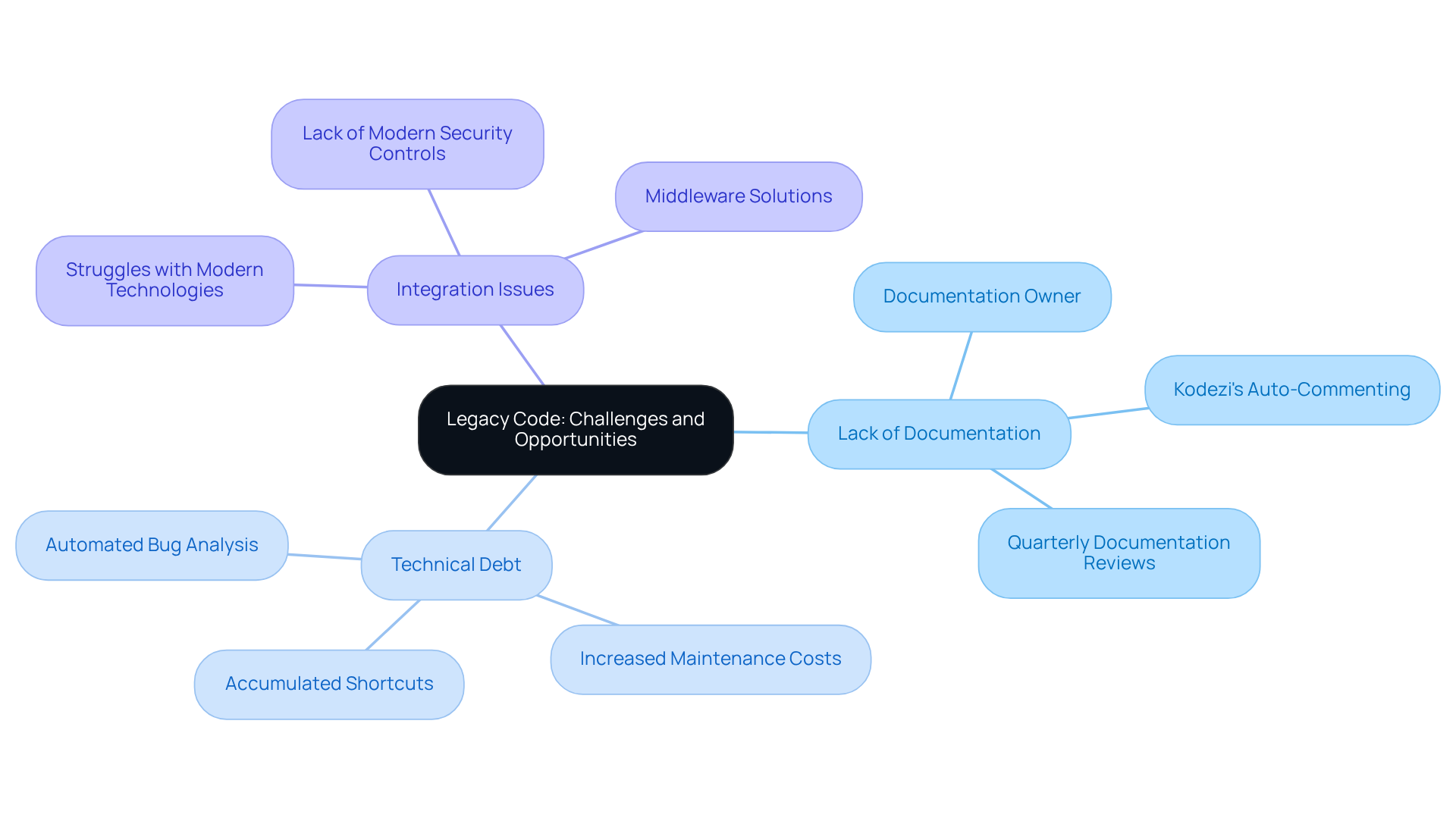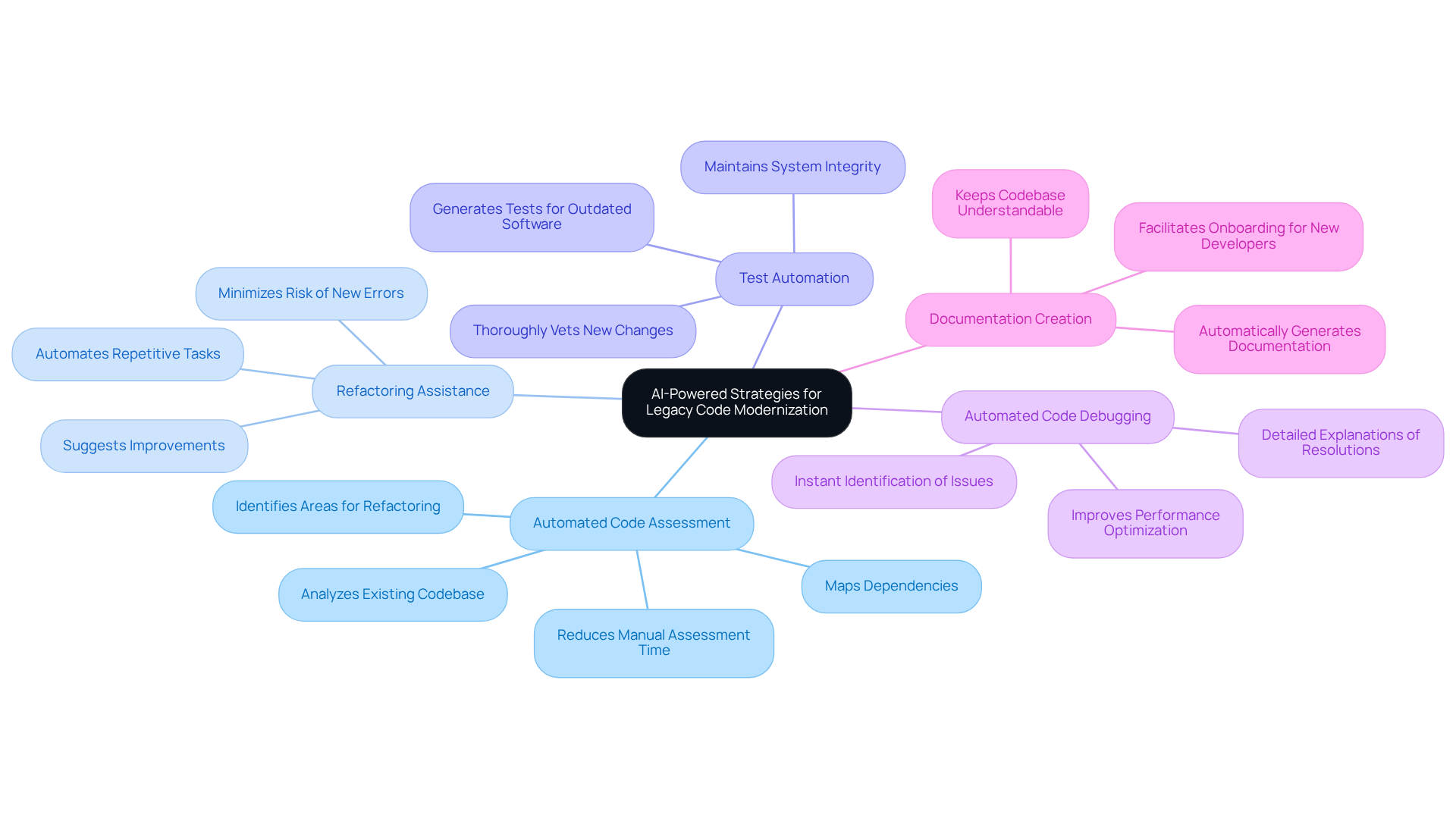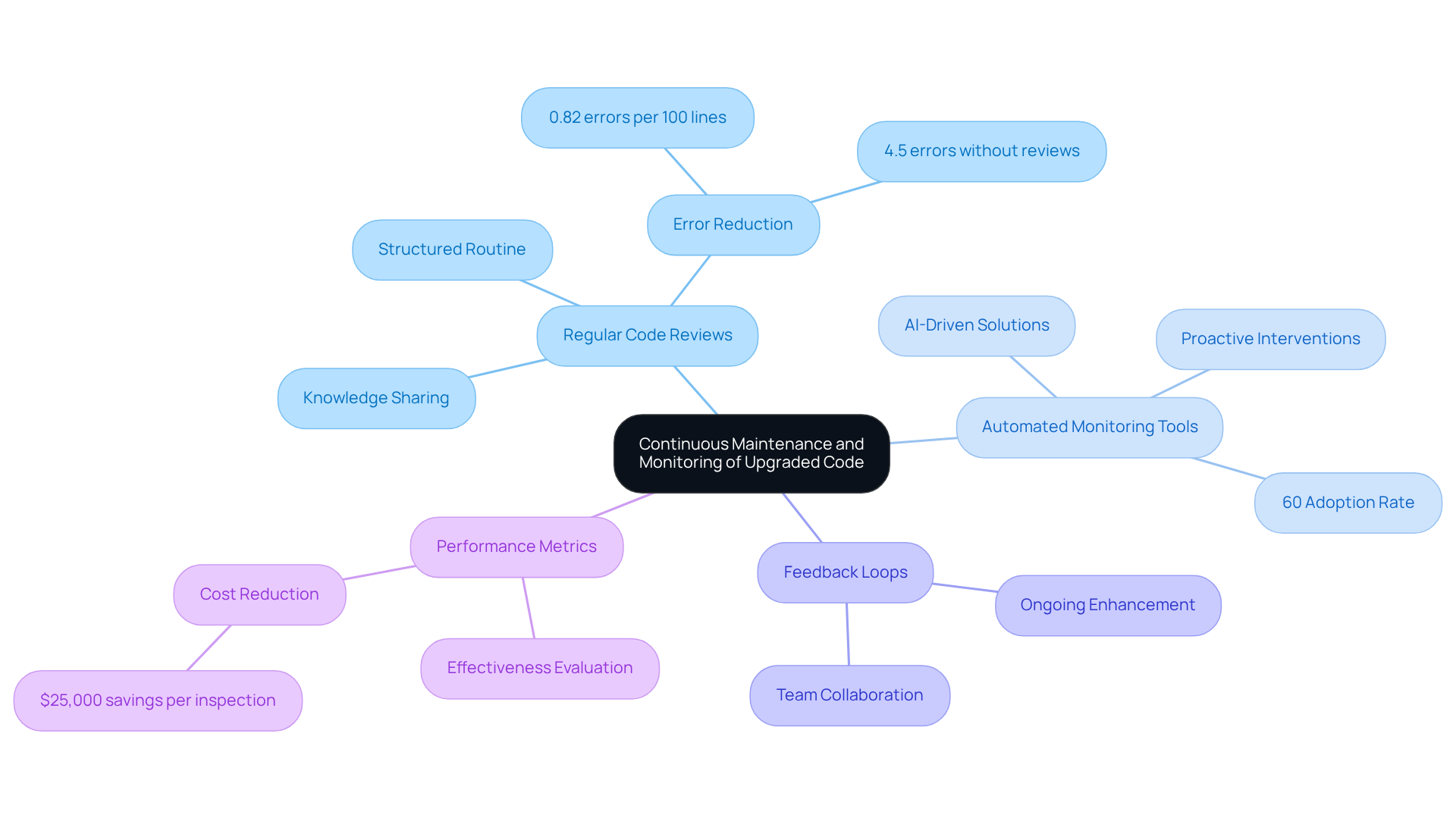Overview
The article addresses the prevalent challenges developers encounter with legacy code. Upgrading such systems can be daunting, but what if there were tools designed to ease this process? Kodezi offers innovative solutions that leverage AI to automate code assessment, assist in refactoring, and provide continuous monitoring. These features not only streamline the modernization process but also significantly reduce technical debt and enhance overall software quality.
Have you ever considered how AI could transform your coding practices? By incorporating Kodezi into your workflow, you can experience remarkable improvements in productivity and code quality. Imagine a scenario where the complexities of legacy systems are managed effortlessly, allowing you to focus on what truly matters—delivering high-quality software.
Furthermore, the benefits of using Kodezi extend beyond just efficiency gains. With its user-friendly interface and powerful AI capabilities, developers can tackle the inherent challenges of legacy systems with confidence. It’s time to take action and explore the tools available on the Kodezi platform. Embrace the future of coding and elevate your software development experience today.
Introduction
Legacy systems are often regarded as the backbone of many organizations, providing invaluable functionality. However, they also present a labyrinth of challenges that can hinder efficiency. The potential for transformation lies in the ability to upgrade these systems with AI. This integration enables businesses not only to streamline operations but also to enhance software quality.
How can organizations navigate the complexities of legacy code while ensuring that modernization efforts yield tangible benefits? Exploring best practices for integrating AI into legacy systems reveals a pathway to overcoming these obstacles and unlocking new opportunities for growth and agility.
Understand Legacy Code: Challenges and Opportunities
Legacy systems often embody a wealth of business logic and functionality, yet they present significant challenges that can hinder organizational efficiency. These challenges are critical for developers to address. How can companies effectively manage these issues?
Lack of Documentation: Many legacy systems were developed without sufficient documentation, complicating the onboarding process for new developers. Insufficient documentation can result in heightened technical debt, as developers may find it difficult to comprehend existing scripts, leading to misaligned updates and extended debugging durations. In fact, 38% of developers cite inadequate documentation as a primary reason for leaving a company, highlighting its critical role in retention and productivity. To mitigate this, assigning a dedicated 'Documentation Owner' for each project can ensure accountability and maintain documentation accuracy. Kodezi can further enhance this process by automatically generating comments and explanations for code, making it easier for new developers to grasp the existing logic.
Technical Debt: Over time, shortcuts taken during development accumulate, creating a fragile codebase that is difficult to maintain. This technical debt not only slows down development but also increases operational costs, consuming up to 70% of IT budgets on maintenance alone. Kodezi addresses this issue by automatically analyzing bugs and providing solutions, which helps reduce the time spent on debugging and allows teams to focus on more strategic initiatives. Increasing operating and maintenance expenses from outdated systems highlight the need for a legacy code AI upgrade, as it impedes business agility and makes it crucial for companies to tackle these challenges proactively.
Integration Issues: Legacy systems often struggle to integrate with modern technologies, limiting the ability to leverage advancements in cloud computing and AI. Additionally, these systems frequently lack modern identity controls, encryption, or compliance tools, complicating modernization efforts and risking operational continuity. Kodezi's assistance for more than 30 programming languages and its connection with Visual Studio Code can promote smoother changes to contemporary development methods, allowing companies to better align their outdated systems with current technological benchmarks.
Despite these challenges, a legacy code AI upgrade presents significant opportunities. By tackling technical debt and improving documentation practices, companies can enhance performance, strengthen security, and notably lower maintenance expenses. For example, companies that effectively update their old applications can achieve a 50% faster time-to-market for new digital products, showcasing the transformative potential of successful modernization strategies. Grasping these dynamics is essential for organizations seeking to manage the intricacies of outdated systems and leverage their inherent value. Explore the tools available on the Kodezi platform to transform your coding practices and improve efficiency.

Implement AI-Powered Strategies for Legacy Code Modernization
In the ever-evolving landscape of software development, the legacy code AI upgrade presents significant challenges for developers. How can teams effectively tackle these obstacles? By leveraging AI-powered strategies, they can streamline the process and enhance overall software quality.
-
Automated Code Assessment is a game changer. AI tools analyze the existing codebase, pinpointing areas that require refactoring or updates. This process includes mapping dependencies and identifying inconsistencies, significantly reducing the time spent on manual assessments.
-
Refactoring Assistance is another essential feature. AI can streamline the refactoring process by suggesting improvements and automating repetitive tasks. This not only speeds up the update procedure but also minimizes the risk of introducing new errors, thereby improving overall quality.
-
Furthermore, Test Automation plays a crucial role. Implementing AI-driven testing frameworks allows for the automatic generation of tests for outdated software. This ensures that new changes are thoroughly vetted, preventing the introduction of bugs and maintaining system integrity.
-
In addition, Automated Code Debugging tools like Kodezi CLI provide instant identification and resolution of codebase issues. They offer detailed explanations and insights into what went wrong and how it was resolved, improving performance optimization and ensuring adherence to the latest security standards and programming guidelines.
-
Lastly, Documentation Creation becomes a breeze with AI. Automatically generating or updating documentation in response to programming changes keeps the codebase understandable and maintainable. This practice facilitates smoother onboarding for new developers and reduces knowledge gaps.
By incorporating these AI strategies, teams can effectively perform a legacy code AI upgrade while significantly enhancing software quality and maintainability. The adoption of AI in this context not only improves efficiency but also aligns with industry trends, where 34% of firms are already utilizing AI to modernize their systems, particularly in sectors such as financial services. Are you ready to explore the tools available on the Kodezi platform to elevate your development practices?

Ensure Continuous Maintenance and Monitoring of Upgraded Code
Maintaining the integrity and performance of a legacy code AI upgrade presents significant challenges for developers. How can you ensure that your codebase remains robust and efficient? A strategic approach to continuous maintenance and monitoring is essential.
-
Regular Code Reviews: Implementing a structured routine for code reviews ensures that all new changes comply with best practices, preventing the introduction of additional technical debt. Studies show that organizations conducting regular reviews experience a notable decrease in mistakes, with software created under this method averaging only 0.82 errors per 100 lines, compared to 4.5 errors for those lacking reviews. This practice not only enhances program quality but also fosters knowledge sharing and mentoring opportunities among team members.
-
Automated Monitoring Tools: Furthermore, leveraging AI-driven monitoring tools like Kodezi CLI autonomously improves your codebase and fixes bugs before they reach production. This tool enhances the effectiveness of software maintenance and enables proactive interventions, ensuring potential issues are managed before they escalate. The adoption of such tools is increasingly recognized in software development, with over 60% of teams utilizing automated monitoring solutions to enhance their workflows. For a quick start, check out the '5 minute quickstart' and see a demo to understand how Kodezi CLI can transform your codebase.
-
Feedback Loops: In addition, establishing mechanisms for developers to provide feedback on the enhanced program cultivates a culture of ongoing enhancement. This enables teams to improve their processes and elevate software quality based on real-world experiences and insights. As noted by industry experts, effective feedback loops can significantly improve team collaboration and project outcomes.
-
Performance Metrics: Similarly, regularly analyzing performance metrics allows organizations to evaluate the effectiveness of modernization efforts. By assessing these metrics, entities can pinpoint areas needing additional enhancement, ensuring the improved software remains effective and aligned with changing business requirements. Early flaw identification through these methods can lead to significant cost reductions, with estimates indicating savings of up to $25,000 per inspection in certain entities.
By prioritizing these strategies, organizations can ensure that their legacy code AI upgrade not only meets current standards but also adapts to future challenges, maintaining security and efficiency over time. Are you ready to explore the tools available on the Kodezi platform?

Conclusion
Upgrading legacy code through AI presents organizations with a unique opportunity to enhance their operational efficiency and adapt to modern technological demands. Developers often face significant challenges, including:
- Inadequate documentation
- Technical debt
- Integration issues
How can organizations effectively address these pain points? By leveraging AI technologies, companies can unlock the potential of their existing codebases and streamline development processes.
One such tool is Kodezi, which simplifies documentation and debugging, making it easier for teams to refactor and assess their code. With features like automated code assessment and continuous monitoring, Kodezi not only enhances productivity but also fosters a more maintainable codebase. Furthermore, regular code reviews and AI-driven monitoring tools ensure that upgraded systems remain robust and aligned with best practices, significantly reducing the risk of introducing new errors.
The significance of investing in legacy code upgrades cannot be overstated. As organizations strive to remain competitive, embracing AI technologies to modernize outdated systems is essential. By prioritizing these best practices, companies can enhance their software quality and position themselves for future success in an ever-evolving digital landscape. The time to explore the tools and strategies for elevating legacy code efficiency is now. Are you ready to pave the way for a more innovative and effective approach to software development?
Frequently Asked Questions
What are the main challenges associated with legacy systems?
The main challenges include lack of documentation, technical debt, and integration issues with modern technologies, which can hinder organizational efficiency.
How does insufficient documentation affect legacy systems?
Insufficient documentation complicates the onboarding process for new developers, increases technical debt, and can lead to misaligned updates and extended debugging durations. It is a significant reason for developer turnover, with 38% citing it as a primary reason for leaving a company.
What is technical debt, and why is it a concern for legacy systems?
Technical debt refers to the accumulated shortcuts taken during development, resulting in a fragile codebase that is difficult to maintain. It slows down development and can consume up to 70% of IT budgets on maintenance, increasing operational costs.
How can companies manage technical debt in legacy systems?
Companies can manage technical debt by utilizing tools like Kodezi, which automatically analyzes bugs and provides solutions, reducing debugging time and allowing teams to focus on strategic initiatives.
What integration issues do legacy systems face?
Legacy systems often struggle to integrate with modern technologies, limiting the ability to leverage advancements in cloud computing and AI. They may also lack modern identity controls, encryption, or compliance tools, complicating modernization efforts.
What opportunities can arise from upgrading legacy code?
Upgrading legacy code can enhance performance, strengthen security, lower maintenance expenses, and improve documentation practices. Companies that successfully modernize can achieve a 50% faster time-to-market for new digital products.
How can Kodezi assist in managing legacy systems?
Kodezi can help by automatically generating documentation, analyzing bugs, providing solutions, and facilitating smoother integration with contemporary development methods, thereby improving the overall efficiency of coding practices.




